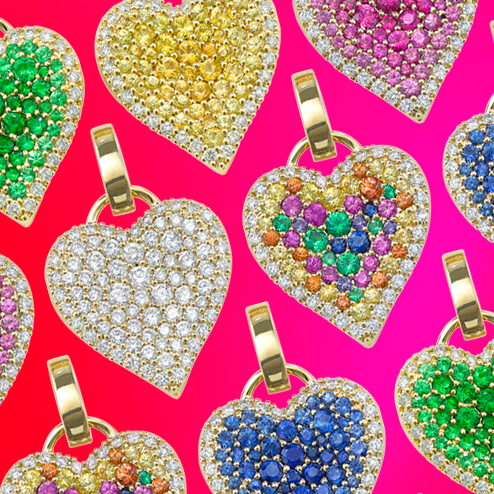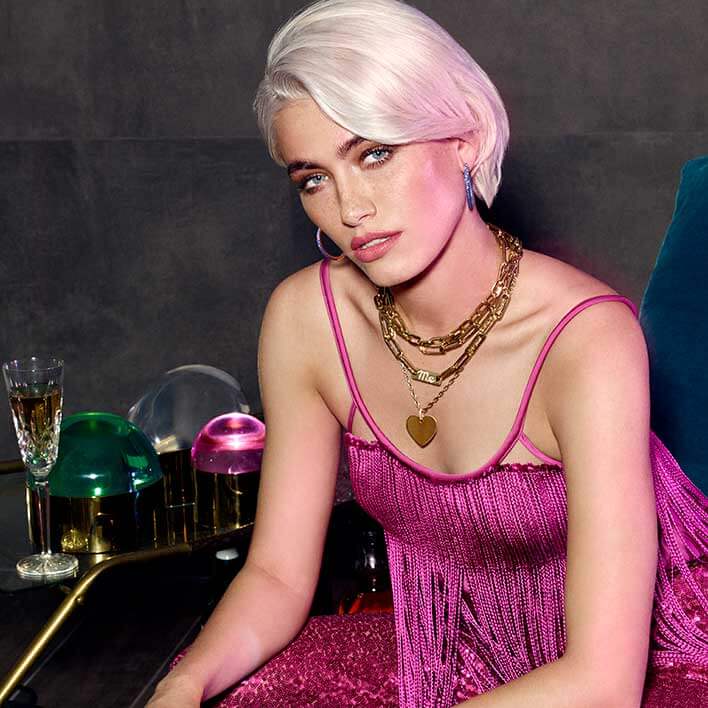Showing love and devotion shouldn’t be limited to Valentine’s Day, our emotions deserve to be on display every day of the year. Here’s how bold, beautiful hearts have symbolised our deepest affections throughout history and how to wear them now.
It’s a simple symbol but the heart has represented love through the ages and across the world. From ancient cave drawings to the most popular new emoji – the flaming heart – the heart shape has come to express love in all its many forms.
When King Edward VII wanted to show Wallis Simpson – and the world – the depth of his feelings for the woman who would motivate him to abdicate the British crown, he presented her with a heart charm which opened to reveal the inscription, ‘The Heart Has Its Reasons’.
Today, couples engrave heart-shaped padlocks with their initials and fasten them at beauty spots to show their commitment to each other. Even likes on social media come in heart form.
When it comes to expressing affection the heart is a universally understood symbol, but where did it come from?
Today, the heart symbol appears in everything from art by Warhol and Banksy to the bright pink hearts projected onto the Eiffel Tower on Valentine’s Day but its origins come from the natural world.
Heart-shaped leaves and fruit have been linked to fertility and potency for a thousand years. Among the earliest hearts were those found on ancient pottery.
Heart-shaped fig and ivy leaves decorated vases in homage to Dionysus, the Greek god of wine and fertility. Later, pears and pinecones painted upside down to resemble hearts and signify adoration were found in religious works of art.
The origins of heart-shaped jewellery
Heart-shaped jewellery emerged in Europe in medieval times with an open heart brooch design, known as a ‘witch’s heart’ which was said to protect against evil spirits and was often pinned to baby’s blankets as a lucky charm.
This style eventually developed into the more intricate ‘Luckenbooth’ design which originated in Scotland and signified that you were ‘bewitched with love’. A single heart showed that you were in a relationship, double, interlocking hearts indicated you were married.
Heart-shaped lockets, often with a tiny key, became a popular gift during Regency days. The idea was that you could lock away a memory of a loved one and wear it close to your heart.
More extravagant lockets were decorated with six gemstones – ruby, emerald, garnet, amethyst, ruby, diamond – whose initials spell ‘regard’. Queen Victoria, who was famously fond of lockets, also owned a gold and enamel charm bracelet with a heart-shaped charm for each of her children.
Since then, whether hearts are worn as charms, pendants, earrings or brooches, they have magically retained their power as a symbol of our affection.
Modern heart-shaped jewellery design
Whether it’s to celebrate Valentine’s Day, an engagement, a wedding or simply as a token of affection, hearts remain the ultimate expression of love.
And this doesn’t surprise Robinson Pelham’s Creative Director Vanessa Chilton.
‘Hearts appear time and time again in our collections,’ she says. ‘They’re a gesture of love, romance or just, “I’m thinking of you”. They are given as gifts for all sorts of reasons and not just on Valentine’s Day.’
Heart-shaped jewellery is gifted on birthdays, wedding days and many other occasions in between, says Chilton. Or just when a heart is the best way to show joy and affection.
‘People buy hearts for all sorts of reasons. We’ve made hearts for fathers to give to their daughters on their wedding days,’ she says. ‘A really lovely man bought a fabulously colourful heart for his elderly mother to thank her for everything she’d done for him and show his affection. She completely loves it.’

Colour is one of the bold, beautiful ways to make a heart stand out from the crowd.
‘At Robinson Pelham we are known for our colour,’ says Chilton. ‘The Fortune Rainbow Pave heart is full of colour. It’s set with diamonds, rainbow sapphires and tsavorites and it’s just so happy.’
In a similar way to the lockets and love tokens of history, engraving a message of affection is a highly personal way to express emotion.
‘The Diamond Set Heart is engravable to make it extra personal and the yellow gold means it’s stunning when the light catches it.’
Of course, pendants aren’t the only way to wear hearts. Just as, through history, hearts have been displayed on rings, charm bracelets and even tiaras, today you can wear a heart any way you choose.
‘We’re all about versatility,’ says Chilton. ‘We want people to be able to mix and match and wear jewellery in different ways. It’s not about having a necklace you only wear on one occasion.’
The charmingly concave shape of the Fortune Heart pendants with their eye-catching diamond edge, means they’re stunning whether worn as a bracelet or necklace.
Stud Club heart shaped earrings come in rubies, diamonds and yellow or white gold while the EarWish Hearts are designed to be worn on hoops or bracelets.
‘Our jewellery is bold and playful but it’s also heartfelt. We pay a lot of attention to detail – the weight of the gold, the curve of the heart, the length of the chain – to make sure we create pieces that will be worn again and again,’ says Chilton.
With all its symbolism and emotion, the power of the heart symbol looks set to continue happily ever after.
Next Article:
Which Necklace Length is Right For You?
When choosing a necklace it is essential that the length of chain is carefully considered. Regardless of the quality of design and materials, if the length is wrong for your unique face, height, and body shape, then it will never look quite right. Here’s everything you need to consider to find your ideal necklace length.

